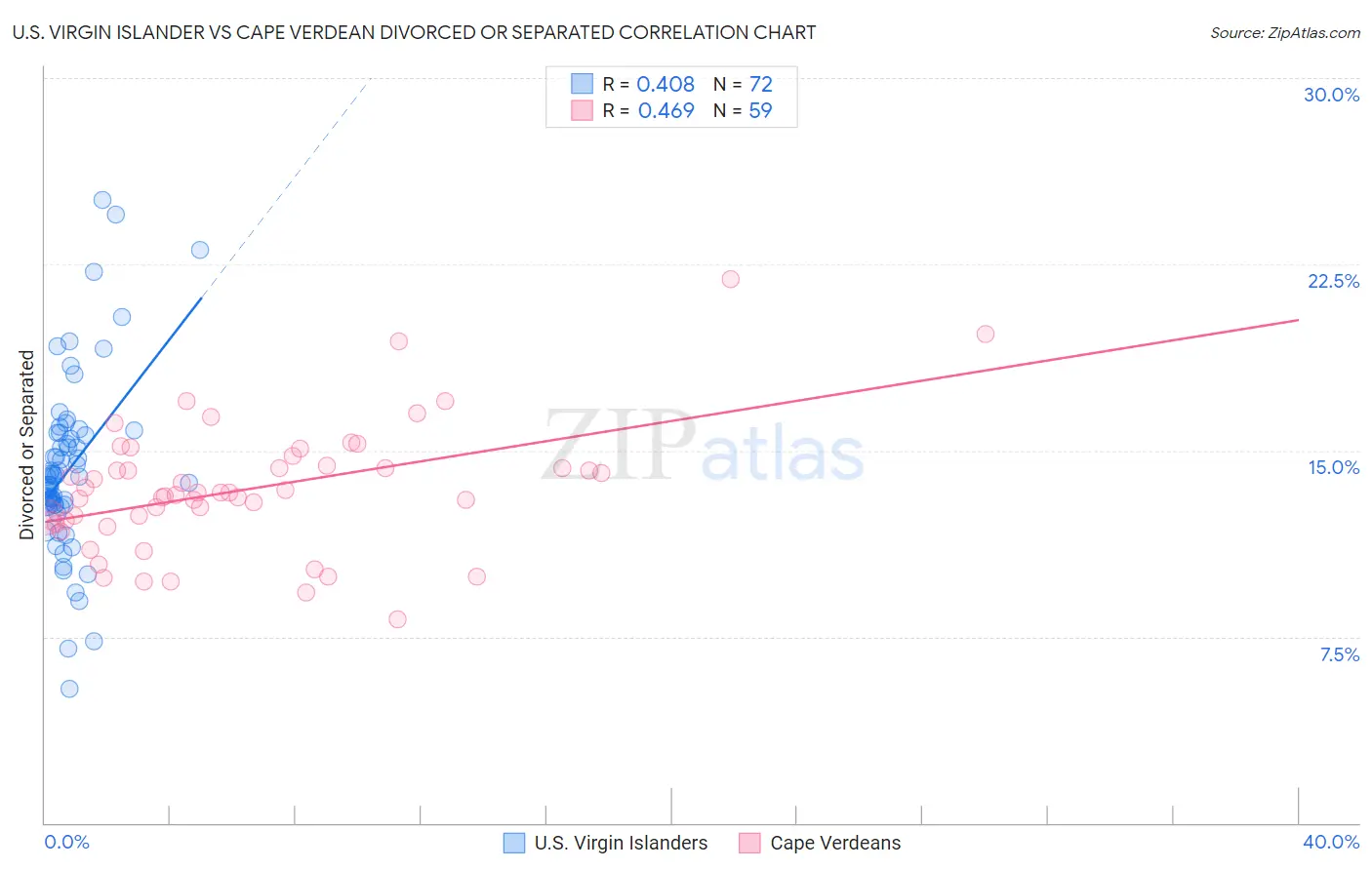U.S. Virgin Islander vs Cape Verdean Divorced or Separated
COMPARE
U.S. Virgin Islander
Cape Verdean
Divorced or Separated
Divorced or Separated Comparison
U.S. Virgin Islanders
Cape Verdeans
13.4%
DIVORCED OR SEPARATED
0.0/ 100
METRIC RATING
323rd/ 347
METRIC RANK
13.1%
DIVORCED OR SEPARATED
0.0/ 100
METRIC RATING
303rd/ 347
METRIC RANK
U.S. Virgin Islander vs Cape Verdean Divorced or Separated Correlation Chart
The statistical analysis conducted on geographies consisting of 87,523,386 people shows a moderate positive correlation between the proportion of U.S. Virgin Islanders and percentage of population currently divorced or separated in the United States with a correlation coefficient (R) of 0.408 and weighted average of 13.4%. Similarly, the statistical analysis conducted on geographies consisting of 107,557,736 people shows a moderate positive correlation between the proportion of Cape Verdeans and percentage of population currently divorced or separated in the United States with a correlation coefficient (R) of 0.469 and weighted average of 13.1%, a difference of 2.3%.

Divorced or Separated Correlation Summary
| Measurement | U.S. Virgin Islander | Cape Verdean |
| Minimum | 5.4% | 8.2% |
| Maximum | 25.1% | 21.9% |
| Range | 19.7% | 13.7% |
| Mean | 14.2% | 13.4% |
| Median | 14.0% | 13.3% |
| Interquartile 25% (IQ1) | 12.8% | 12.2% |
| Interquartile 75% (IQ3) | 15.7% | 14.4% |
| Interquartile Range (IQR) | 2.9% | 2.2% |
| Standard Deviation (Sample) | 3.6% | 2.6% |
| Standard Deviation (Population) | 3.5% | 2.5% |
Demographics Similar to U.S. Virgin Islanders and Cape Verdeans by Divorced or Separated
In terms of divorced or separated, the demographic groups most similar to U.S. Virgin Islanders are Immigrants from Haiti (13.4%, a difference of 0.22%), Cheyenne (13.4%, a difference of 0.46%), Cajun (13.4%, a difference of 0.56%), Puget Sound Salish (13.4%, a difference of 0.62%), and Cree (13.4%, a difference of 0.66%). Similarly, the demographic groups most similar to Cape Verdeans are Hopi (13.2%, a difference of 0.13%), Chippewa (13.2%, a difference of 0.18%), Tlingit-Haida (13.2%, a difference of 0.35%), French American Indian (13.2%, a difference of 0.60%), and Ottawa (13.2%, a difference of 0.69%).
| Demographics | Rating | Rank | Divorced or Separated |
| Cape Verdeans | 0.0 /100 | #303 | Tragic 13.1% |
| Hopi | 0.0 /100 | #304 | Tragic 13.2% |
| Chippewa | 0.0 /100 | #305 | Tragic 13.2% |
| Tlingit-Haida | 0.0 /100 | #306 | Tragic 13.2% |
| French American Indians | 0.0 /100 | #307 | Tragic 13.2% |
| Ottawa | 0.0 /100 | #308 | Tragic 13.2% |
| Americans | 0.0 /100 | #309 | Tragic 13.2% |
| Africans | 0.0 /100 | #310 | Tragic 13.2% |
| Sioux | 0.0 /100 | #311 | Tragic 13.2% |
| Blackfeet | 0.0 /100 | #312 | Tragic 13.3% |
| Immigrants | Nicaragua | 0.0 /100 | #313 | Tragic 13.3% |
| Yaqui | 0.0 /100 | #314 | Tragic 13.3% |
| Spanish Americans | 0.0 /100 | #315 | Tragic 13.3% |
| Tsimshian | 0.0 /100 | #316 | Tragic 13.3% |
| Haitians | 0.0 /100 | #317 | Tragic 13.3% |
| Cree | 0.0 /100 | #318 | Tragic 13.4% |
| Puget Sound Salish | 0.0 /100 | #319 | Tragic 13.4% |
| Cajuns | 0.0 /100 | #320 | Tragic 13.4% |
| Cheyenne | 0.0 /100 | #321 | Tragic 13.4% |
| Immigrants | Haiti | 0.0 /100 | #322 | Tragic 13.4% |
| U.S. Virgin Islanders | 0.0 /100 | #323 | Tragic 13.4% |